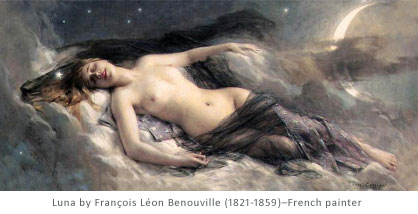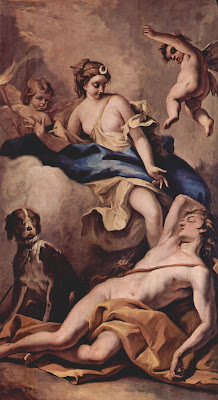In Greek mythology Selene (also called Mene) is the Titan goddess of the moon. Her Roman counterpart is Luna. Pursuant to prevalent accounts, she is the daughter of Hyperion and Theia and a sister to Helios(Roman equivalent: Sol) and Eos (Roman equivalent: Aurora). However, some other sources ascribe her as the daughter of Hyperion and Euryphaessa, or of Pallas and Euryphaessa, or of Zeus and Latona, or lastly of Helios.
Selene is often associated with other moon goddesses such as Artemis (Roman equivalent: Diana) and Hecate (Roman equivalent: Trivia). However, in artworks they are distinguished as three different deities. In essence, neither Artemis nor Hecate was worshipped singly as the moon goddess, rather they were revered for a number of purposes. For instance, Artemis was worshiped as the goddess of chastity, virginity, the hunt, the moon, and the natural environments.Again, Hecate was worshiped as the goddess of magic, witchcraft, the night, moon, ghosts and necromancy. On the contrary, Selene was venerated solely as the personification of the moon itself. Due to her association with Artemis, her brother Helios is identified with Apollo (also called: Phoebus). Consequently, Selene is frequently called Phoebe (fem. of Phoebus).
In art, Selene is portrayed as a very beautiful young lady with an exceptionally pale face. She usually dressed in a long robe and had a lunate crown above her head. Like her brother Helios, Selene journeyed across the sky in a silver chariot drawn by two winged horses. However, in some artworks her chariot was drawn by two oxen or mules and her crown was resembled more like the horns of a bull. Selene started her journey soon after her brother Helios completed his. Myths account that she bathed in the sea before initiating her journey across the sky.
She is best known for her passionate love for Endymion, the handsome son of Zeus, who is diversely known as either a shepherd, or a hunter, or a king. Selene was so attracted with Endymion’s unmatched beauty that she granted him the gift of everlasting youth from Zeus. Another account relates that Selene was so deeply moved by the way Endymion looked while he was asleep in a cave that she requested Zeus to keep him like that forever. Still another myth suggests that Selene was so obsessed with Endymion that she asked Zeus to allow him to decide his own destiny. Accordingly, Zeus granted her request and Endymion chose to sleep eternally without having susceptible to aging or death. It is said that while Endymion dreamt of holding the moon in his arms, Selene bore him fifty daughters representing the fifty lunar months of an Olympiad, the four-year span between Olympic Games.
Different sources refer that she had a few other love affairs. For instance, by her affair with Zeus, Selene became the mother of three daughters: Pandia, the Goddess of Brightness, Ersa, the Goddess of Dew, and Nemea, the Mountain Goddess. There is also another myth that Pan, the god of shepherds and flocks seduced Selene and gave her the gift of a white horse.
“Selene.” Wikipedia. 2015. Wikimedia Foundation, Inc. 20 Sep 2015
< https://en.wikipedia.org/wiki/Selene>.
“Selene - Goddess of the Moon.” The White Goddess. 2015. The White Goddess. 20 Sep 2012
< http://www.thewhitegoddess.co.uk/the_goddess/selene_-_goddess_of_the_moon.asp>.
“Selene.” Greek Mythology. 2015. GreekMythology.com. 20 Sep 2015
< http://www.greekmythology.com/Titans/Selene/selene.html>.
“Selene.” Encyclopædia Britannica. 2015. Encyclopædia Britannica, Inc. 20 Sep 2015
< http://global.britannica.com/topic/Selene-Greek-and-Roman-mythology>.
“Selene.” Loggia. 2008. Loggia.com. 20 Sep 2015
< http://www.loggia.com/myth/selene.html>.
“Selene.” Encyclopedia Mythica. 2015. MCMXCV-MMIX Encyclopedia Mythica. 20 Sep 2015
< http://www.pantheon.org/articles/s/selene.html>.
“Selene.” Theoi. 2015. Theoi. 20 Sep 2015
< http://www.theoi.com/Titan/Selene.html>.
“Selene.” Greek Myth Index. 2007. Myth Index. 20 Sep 2015
< http://www.mythindex.com/greek-mythology/S/Selene.html>.
“Selene” Microsoft Encarta. DVD-ROM. Redmond: Microsoft, 2005.
Selene is often associated with other moon goddesses such as Artemis (Roman equivalent: Diana) and Hecate (Roman equivalent: Trivia). However, in artworks they are distinguished as three different deities. In essence, neither Artemis nor Hecate was worshipped singly as the moon goddess, rather they were revered for a number of purposes. For instance, Artemis was worshiped as the goddess of chastity, virginity, the hunt, the moon, and the natural environments.Again, Hecate was worshiped as the goddess of magic, witchcraft, the night, moon, ghosts and necromancy. On the contrary, Selene was venerated solely as the personification of the moon itself. Due to her association with Artemis, her brother Helios is identified with Apollo (also called: Phoebus). Consequently, Selene is frequently called Phoebe (fem. of Phoebus).
In art, Selene is portrayed as a very beautiful young lady with an exceptionally pale face. She usually dressed in a long robe and had a lunate crown above her head. Like her brother Helios, Selene journeyed across the sky in a silver chariot drawn by two winged horses. However, in some artworks her chariot was drawn by two oxen or mules and her crown was resembled more like the horns of a bull. Selene started her journey soon after her brother Helios completed his. Myths account that she bathed in the sea before initiating her journey across the sky.
She is best known for her passionate love for Endymion, the handsome son of Zeus, who is diversely known as either a shepherd, or a hunter, or a king. Selene was so attracted with Endymion’s unmatched beauty that she granted him the gift of everlasting youth from Zeus. Another account relates that Selene was so deeply moved by the way Endymion looked while he was asleep in a cave that she requested Zeus to keep him like that forever. Still another myth suggests that Selene was so obsessed with Endymion that she asked Zeus to allow him to decide his own destiny. Accordingly, Zeus granted her request and Endymion chose to sleep eternally without having susceptible to aging or death. It is said that while Endymion dreamt of holding the moon in his arms, Selene bore him fifty daughters representing the fifty lunar months of an Olympiad, the four-year span between Olympic Games.
Different sources refer that she had a few other love affairs. For instance, by her affair with Zeus, Selene became the mother of three daughters: Pandia, the Goddess of Brightness, Ersa, the Goddess of Dew, and Nemea, the Mountain Goddess. There is also another myth that Pan, the god of shepherds and flocks seduced Selene and gave her the gift of a white horse.
References
“Luna” Microsoft Encarta. DVD-ROM. Redmond: Microsoft, 2005.“Selene.” Wikipedia. 2015. Wikimedia Foundation, Inc. 20 Sep 2015
< https://en.wikipedia.org/wiki/Selene>.
“Selene - Goddess of the Moon.” The White Goddess. 2015. The White Goddess. 20 Sep 2012
< http://www.thewhitegoddess.co.uk/the_goddess/selene_-_goddess_of_the_moon.asp>.
“Selene.” Greek Mythology. 2015. GreekMythology.com. 20 Sep 2015
< http://www.greekmythology.com/Titans/Selene/selene.html>.
“Selene.” Encyclopædia Britannica. 2015. Encyclopædia Britannica, Inc. 20 Sep 2015
< http://global.britannica.com/topic/Selene-Greek-and-Roman-mythology>.
“Selene.” Loggia. 2008. Loggia.com. 20 Sep 2015
< http://www.loggia.com/myth/selene.html>.
“Selene.” Encyclopedia Mythica. 2015. MCMXCV-MMIX Encyclopedia Mythica. 20 Sep 2015
< http://www.pantheon.org/articles/s/selene.html>.
“Selene.” Theoi. 2015. Theoi. 20 Sep 2015
< http://www.theoi.com/Titan/Selene.html>.
“Selene.” Greek Myth Index. 2007. Myth Index. 20 Sep 2015
< http://www.mythindex.com/greek-mythology/S/Selene.html>.
“Selene” Microsoft Encarta. DVD-ROM. Redmond: Microsoft, 2005.













0 comments:
Post a Comment